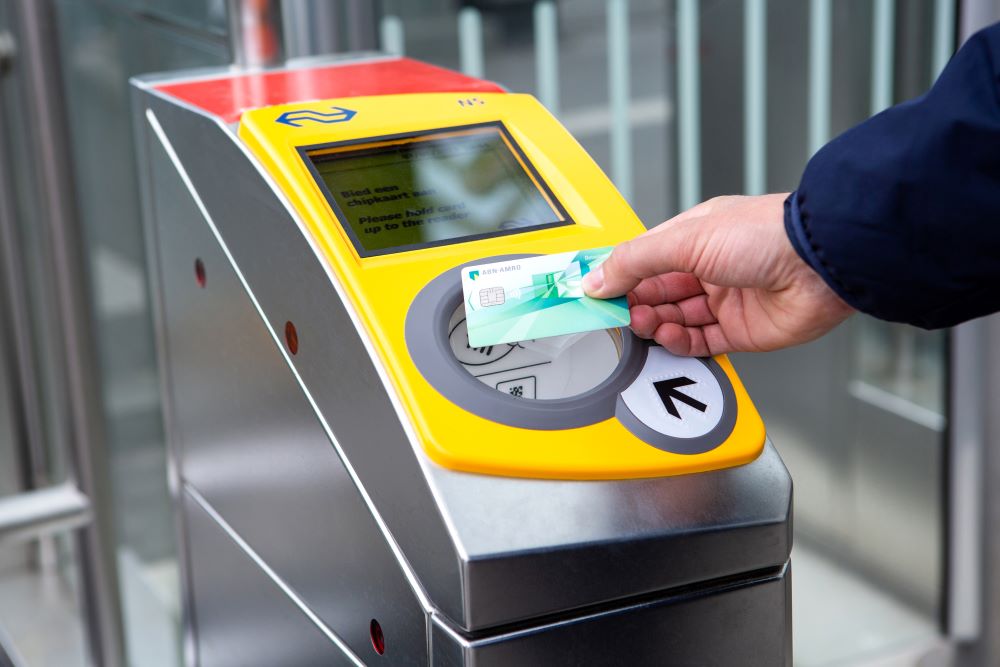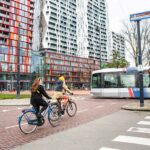
The opportunities of bankcard payment technology
Paul Meerman, Business Developer at Technolution
Passengers have become accustomed to checking in and out of public transport using a bank- or credit card (or the smartphone version of their cards). This system’s greater ease of payment has made public transport more accessible. But this is only the beginning, says Paul Meerman of Technolution, the technology partner of Translink, GVB, RET and regional carriers. This new payment method offers many more opportunities for making traveling easier. The technology is there –
what we need now are ideas.
Fundamentally different
Paying by bankcard is fundamentally different from paying by OV-chipkaart. When they use an OV-chipkaart, passengers top up the credit on their pass, and the fare charged is calculated immediately upon checking out. No useful information is stored. But when passengers use a bankcard to pay, fare calculation is done at the end of the day, and is linked to the passenger’s account. In other words: data is created.
And this makes all the difference. The travel data constitutes valuable information. This information can be used to develop all kinds of new services. Of course, one essential precondition is that laws governing bank payments and passenger privacy are fully respected. But if this can be guaranteed, the opportunities for user-friendly and attractive transportation services are unlimited.
Easy applications
Some ideas are obvious. One of them is to connect train journeys with Park & Ride (P+R). Passengers park their car at a P+R car park near the station and then take the train to complete their journey, and the same on the way back, checking in and out everywhere using their bankcard. Carriers could then use parking and travel data to give such passengers a discount on the parking fee. The first steps are already being made to implement this service.
Other obvious applications exist. At the moment, passengers still need an OV-chipkaart to check an OV-fiets (a bike from a shared bike scheme) in and out. This service, too, can be linked to bankcards using the new payment technology. There are further opportunities for innovation here. Carriers could for example give passengers a discount on the OV-fiets or even offer one for free in combination with long train journeys, or offer seasonal rates for frequent use of the OV-fiets.
Data-driven services
And if we dream a little further, bankcard payments are an incredibly rich source of possibilities. We’ve mentioned parking. But consider charging electric vehicles. Using this data-driven technology, it would be possible to offer discounted rates to public transport passengers who charge their car at a P+R car park. This would be an additional incentive to use an electric vehicle! And in addition, charging cars during the day will help prevent power grid congestion.
There is more. Many people use transportation for specific target groups, such as special needs transportation or school buses. This type of transportation is often funded by external sources, such as health insurers or municipal authorities. We could provide carriers in this sector with user-friendly check-in and check-out facilities – for example a card reader and a mobile app. All we’d need to do then is to link the bankcard systems to the systems of the health insurer, municipal body, or other institution. Passengers who use this type of transportation can then check in and out easily and their own contribution is calculated automatically.
Mobility packages
The bankcard payment technology also offers many new opportunities to employers and employees. Carriers could offer employers a ‘mobility package’ that their employees can use to pay for various transportation services, again by checking in and out with their bankcard. Employers purchase these packages for their employees, who then use their allocated budget for either public transport, paying for parking fees, charging electric vehicles, or riding shared vehicles, scooters, or bikes, etc.
The carriers are guaranteed custom, which permits them to offer attractive discounts. Employees are free to spend their travel budget in whatever way suits their needs best. Both employers and employees benefit from the discounts, and the employer’s travel expenses administration is much simplified and in any case mostly outsourced.
Making a dream come true
The ideas presented above, I think, mark only the start of a long, fascinating journey. More creative minds than mine can surely think of many other great applications. But the question is: how do we make this dream come true?
Let me emphasize straightaway: the technology is there. The payment method that we now use to check in and out of trains, trams, buses, and the metro can simply be used for other services. But this does require work. I know from my experience developing payment technologies at Technolution (for the OV-chipkaart and OVpay for example) that realizing this dream requires hard work. The biggest challenge is getting all stakeholders together to consult and come to agreements. If they are able to formulate a common vision, the technical realization will still be difficult, but there is no doubt that this is feasible.
It’s time for further steps
The time has come to take this a step further. It begins with vision, original ideas, and open conversations about them. Carriers could take the lead here, but initiatives may also come from other quarters in society, for example health insurers or municipal authorities. What is clear is that this will lead to interesting discussions, which will hopefully result in valuable solutions for passengers, carriers, and other stakeholders. And let me repeat: the privacy of passengers must remain the main priority in all these developments.
At Technolution, we are ready to support this exciting process with technological and substantive expertise. Not just in the field of payment technology, but also of security, mobility, and system integration.



